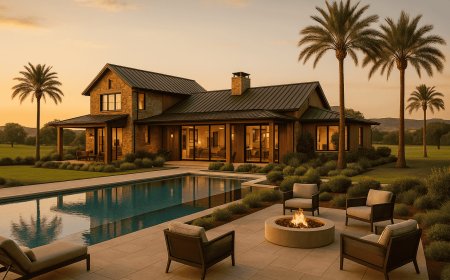Mastering Room Balance: Symmetry vs. Asymmetry in Interior Layouts
Learn how to design perfectly balanced rooms using symmetrical and asymmetrical layouts. Explore expert guidance from an experienced Interior Designer in Gurgaon for refined yet functional interiors.
Getting Room Balance Right: Symmetry or Asymmetry?
Setting up a room is more than just dropping in furniture. It's about making a space that looks good and feels right for how you live. One key idea is balance, which you can achieve in two main ways: symmetry and asymmetry. Each has its own vibe and level of formality, and knowing when to use each can totally change a room.
In Gurgaon, you see all sorts of homes, from new apartments to big, older houses. Everyone has different needs and likes. That's why knowing about these two layout styles is super important. It helps you create rooms that look great and actually work for you. Whether you're fixing up your living room or redoing a bedroom, deciding on symmetry or asymmetry is the first step.
Good designers in Gurgaon often mix both styles to make spaces that feel solid but still interesting. Let's check out how these styles work and how you can nail the balance thing in your own place.
What's the Deal with Symmetry?
Symmetry is basically about copying stuff across a center line. Think about a room where two matching couches face each other with a table in the middle. Or a bed with the same nightstands and lamps on each side. It's an old-school trick that makes things feel calm and organized.
Symmetrical layouts are great in formal living rooms. They make your eyes feel relaxed and give a sense of order. They're perfect for bigger houses that already have natural center points, like fancy lights, fireplaces, or big windows.
But symmetry doesn't have to be boring. You can add different textures, materials, or colors to shake things up. For example, you could have similar chairs but with slightly different fabrics. Even in modern apartments, you can use balanced wall art, lights, or furniture that echoes itself.
Stylome Interiors often uses symmetry in Gurgaon homes with formal areas or square living rooms. If you do it right, it makes a space feel fancy without being too over the top.
The Vibe of Asymmetry
Asymmetry is more about creating interest. Instead of copying things, you balance them with different shapes, sizes, colors, or weights. A single couch with a bunch of different side tables, or a big piece of art balanced by shelves or plants, can make a room feel more alive.
Asymmetrical layouts are more fun and are often used in casual or open living areas. They give you more room to play around, especially in homes that mix different uses in one area, like a dining and lounge space in a small apartment.
This style also works well with weird room shapes, which are common in older houses or renovated apartments in Gurgaon. If you have a window that's off-center or a strange wall, asymmetry lets you work with it instead of trying to hide it.
A good interior designer in Gurgaon might use asymmetry to create interesting focal points or show off what the homeowner likes. It's popular with younger people who want a more relaxed, less traditional design.
Which Way Should You Go?
Choosing between symmetry and asymmetry isn't a one-or-the-other thing. It depends on what your room needs and how you want it to feel. Symmetry is best for rooms where you want things to feel formal and predictable, like dining rooms, guest bedrooms, or formal lounges. It feels timeless and clean, which works well with classic or simple interiors.
Asymmetry is great for being creative and showing off your personality. It's ideal for media rooms, open kitchens, kids' rooms, or home officesplaces where you want to move around and add personal touches.
You also have to think about what's realistic. In skinny living rooms or weirdly shaped bedrooms, trying to force symmetry might make things look awkward. In those cases, asymmetry lets the design breathe. For example, you could put a bed off to the side but balance it with a tall mirror and a cool floor lamp on the other side.
A lot of people in Gurgaon are now doing a mix of both. They use some structured elements to create balance, but add in some playful asymmetry to make things more interesting. The result is a space that feels put-together but not boring.
Getting Balance Without Exact Matches
Balance doesn't always mean using identical stuff. Asymmetry often works best when you pair different things that have the same visual weight. A tall, skinny bookshelf can balance a short, wide cabinet. A striking artwork can be balanced by a group of smaller frames or even plants. The idea is to make it feel balanced without being obvious.
Even in symmetrical layouts, too much of the same thing can feel boring. Changing up textures, mixing materials like glass and wood, or using asymmetrical lighting (like a single hanging light on one side and a wall light on the other) can soften the symmetry and make it feel more natural.
Color also matters. A bright pillow on one side of a couch might be balanced by a patterned rug or colorful art somewhere else. This is extra helpful in Gurgaon homes where people often stick to neutral colors because of dust and heat. Adding pops of color and asymmetrical touches can make a space feel warmer and more personal.
Why Focal Points Are Important
Whether you go for symmetry or asymmetry, a good layout almost always has a focal point. In symmetrical rooms, everything points to this center, like a fireplace, a piece of art, or a TV. In asymmetrical rooms, the focal point still matters, but it might change a bit depending on how you're using the room.
In Gurgaon's modern homes, focal points can be anything from a cool wall design to a big window with a view. Finding and playing up this feature can help you figure out how to arrange the furniture and decor. Even asymmetrical rooms need this grounding point, or they can feel messy.
An experienced interior designer in Gurgaon can help you find the right focal point and make sure it not only looks good but also makes the room work better.
Balance Is a Feeling, Not a Rule
At the end of the day, good design isn't about following rules. It's about creating a feeling. Whether you like symmetry or asymmetry, the main thing is to make a space that feels balanced. Not every room has to be a perfect mirror image, and not everything has to match. What's important is how the space makes you feel: welcome, useful, and real.
Symmetry makes you feel calm, asymmetry makes you feel energized, and both have their place. The best rooms often mix the two, creating a vibe that changes with how you live.
In Gurgaon, where homes are as different as the people who live in them, finding this balance is both a challenge and a chance to get creative. And with the right designer, even the strangest room can feel perfectly balanced.











































